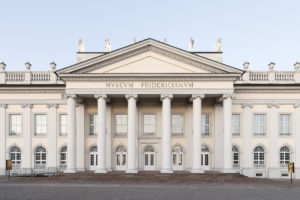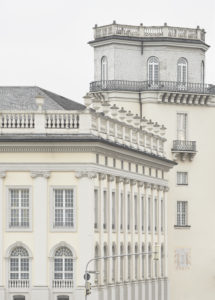The Fridericianum was opened in 1779 to provide public access to the collections of the Landgraves of Hesse and is closely tied to the development of the European Enlightenment idea of the museum. When private royal collections were transferred to public ownership, the bourgeoisie adopted art as a medium for reflection, prestige, and interpretative authority. During the postwar period, the Fridericianum began being used exclusively for exhibitions, and the first documenta in 1955 restricted itself entirely to the museum. Since then, the building has repeatedly been the focus of subsequent editions and has come to be considered as the main venue of documenta.
For the duration of documenta fifteen, the former exhibition building has become Fridskul (Fridericianum as school) and is being used by artists and collectives to apply and demonstrate different models of horizontal education that are rooted in life. ruangrupa, the Artistic Team, and the artists and collectives occupying the Fridericianum see it as a lumbung—a practice of sharing and a form of architecture often used to store harvests in Indonesian. As a lumbung, as both a domestic place and a social space where all can gather, the cold museum space of the Fridericianum becomes a warm and dynamic place. The different artists and collectives of Fridskul view their relationship as that of neighbors and will host and collaborate with each other on various programs. The host of Fridskul is the Gudskul collective from Indonesia, of which ruangrupa is a founding member. Gudskul is running workshops, seminars, knowledge-market events, and karaoke nights with other collectives. During periodic meetings, a collective decision was made to house the Fridskul library in the Fridericianum’s rotunda. A dormitory and kitchen have been installed on the ground floor of the building, where participating artists and students can eat and sleep during the 100 days of the exhibition.
At Fridskul, OFF-Biennale Budapest imagines a Transnational Museum of Roma Contemporary Art (“RomaMoMA”). The ground floor houses RURUKIDS, an initiative founded by ruangrupa in 2010 to enable artists to work with children and teenagers. An evolving installation, including paintings and drawings, recreates the studio environment of Project Art Works in Hastings, UK. Dan Perjovschi draws on the columns of the Fridericianum, representing central themes of documenta fifteen. Focusing on the archive, The Black Archives from the Netherlands, the Asia Art Archive from Hong Kong, and the Archives des luttes des femmes en Algérie from Algeria, show what archival practices can become when they are tied to protest and community.
At the invitation of lumbung member OFF-Biennale Budapest and as part of “RomaMoMA”, Sead Kazanxhiu has equipped the façade of the Fridericianum with his installation The Nest (2012–2022). The nests, made of wood, metal wire, polyurethane foam, and paint, blend into the architecture so that they are not immediately recognizable as artistic contributions. The Nest was first installed at the Albanian National Museum in Tirana in 2012. The work calls for the institutionalization of Roma history, art, and culture. Reminiscent of giant swallows’ nests, the artist articulates a position between homeliness and strangeness.
Opening Hours
Daily from 10 am to 8 pm
Directions
Friedrichsplatz 18, 34117 Kassel
Accessibility
Access:
The main entrance of the building is accessible via a ramp (with an approx. 8% incline). The area right in front of the building consists of cobblestones. If you need assistance, please contact our supervisory staff on site. There are two elevators (125 x 145 cm) in the foyer that provide access to all levels. Allmost all exhibition rooms are barrier-free and have wheelchair-accessible passageways, with the exception of two rooms in the Zwehrenturm. The rooms of the basement, which are accessible from outside by means of a staircase, can only be reached at ground level via the basement of the Fridericianum building with a narrow ramp.
Bathrooms:
In the basement there are two barrier-free bathrooms with baby-changing tables. A changing place with a couch and a hoist is situated in the ground floor on the east side of the building. Contact our staff, they will show you the way.
Breastfeeding:
There are changing tables in the two regular barrier-free bathrooms on the lower floor. You are welcome to breastfeed your child at RURUKIDS. Our staff will be happy to help you find your way around.
Parking:
You can find a detailed map of the city of Kassel here (in German language). Selection in the topic layer “Themen-Layer”: Verkehr & Mobilität + Behindertenparkplätze
lumbung members & artists
in this venue

